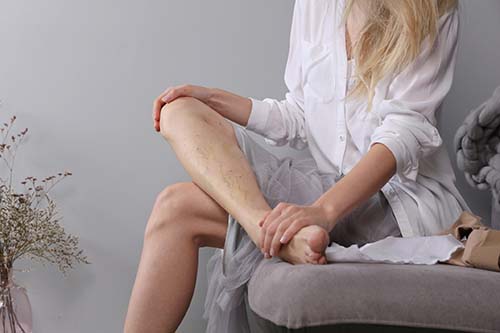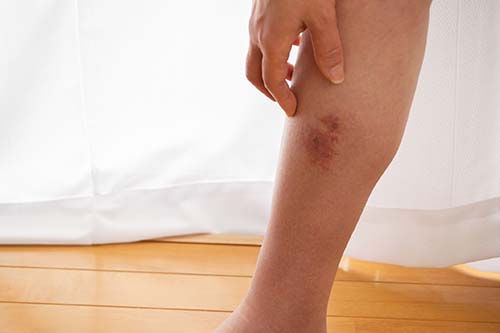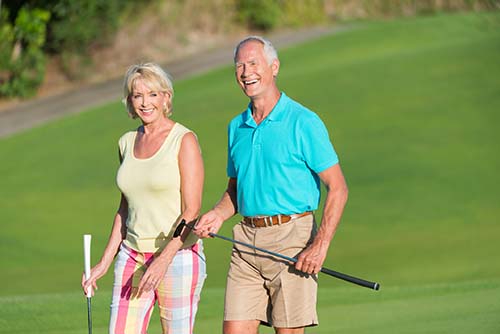Symptoms of varicose veins and spider veins can range from barely noticeable to incapacitating and may include sensations such as pressure, heaviness, fatigue, stiffness, aching, and itching. These symptoms can wax and wane depending on various factors and can vary from person to person. Varicose vein and spider vein symptoms can also be confused with symptoms of other underlying conditions, leading patients to wonder why they experience these symptoms and what they mean. Here we discuss three of the most common varicose and spider vein symptoms, why they arise, what you can do to prevent them, and how to best treat them.

Why Do My Leg Veins Itch?
Varicose and spider veins near the skin can cause itching when blood pools in them and increases the pressure in the veins, resulting in blood leaking out into the surrounding tissues, a condition known as stasis dermatitis or venous eczema. This causes irritation that leads to inflammation and reduces the skin’s ability to exchange oxygen and waste products. The inflammatory process also prompts the release of histamine, which activates sensory receptors in the skin that you perceive as an itch.
As stasis dermatitis progresses the skin becomes fragile, dry, and scaly and the itchy symptoms can become more intense. Scratching temporarily alleviates the itching, but it can further damage the skin and the veins and lead to the development of open sores.
The American Academy of Dermatology recommends various treatments for stasis dermatitis depending upon the severity of symptoms. These may include:
- A topical corticosteroid cream to help reduce swelling.
- Antihistamine pills to control the itching.
- Moisturizer to hydrate the skin and prevent sores.
- Instructions for elevating the legs and wearing compression stockings.
- An antibiotic prescription to help fight the infection, if a sore develops and becomes infected
- A referral to a qualified vascular surgeon for vein treatment, if needed[1].
Why Do My Legs Burn?
Burning sensations from varicose and spider veins can arise due to underlying venous insufficiency in a similar manner to that which causes itching. As blood flow slows, the delivery of oxygen and nutrients to cells and tissues declines, and waste products build up. Blood begins to pool in the veins causing venous blood pressure to increase. Eventually, fluid leaks out of the veins into surrounding tissues and irritates them, activating pain-sensing nerves. If varicose eczema is present, it can also cause burning sensations. Whether you experience burning or itching from varicose veins or venous eczema depends upon the location and degree of sensory nerve activation.
Varicose and spider veins that cause burning sensations can often be managed conservatively using diet and exercise to reduce excess weight and promote healthy circulation. When burning pain occurs, elevating the legs helps improve blood flow and reduces the venous pressure, fluid leakage, and swelling that causes these symptoms. Similarly, cold compresses or soaking the lower legs in cold water can also reduce swelling and pressure and calm the burning. Additionally, since burning and itching are related symptoms with similar causes, the application of a topical antihistamine cream may help with the management of burning pain arising from venous insufficiency.

Varicose veins also increase your risk for developing a condition called superficial thrombophlebitis in which a clot develops in a vein[2]. Superficial thrombophlebitis causes turbulent blood flow leading the vein wall to become inflamed and swollen, which results in symptoms such as warmth, redness, tenderness, swelling, and pain in the affected leg.
Usually, superficial thrombophlebitis resolves on its own over several weeks. Application of warm compresses and the use of nonsteroidal anti-inflammatory drugs such as ibuprofen or aspirin can help speed the healing process. In some instances, medical treatment for the affected vein may be necessary[3].
Another possible cause of burning pain in the legs is peripheral artery disease (P.A.D.). In this condition, the arteries of the legs become narrowed and hardened due to plaque buildup, similar to the process that occurs in coronary artery disease. P.A.D. reduces blood supply to the legs and causes symptoms such as pain, cramping, and burning sensations in the legs, particularly when walking. Early stage P.A.D. can be managed conservatively with medication and dietary changes to reduce cholesterol levels and supervised exercise to build strength and promote better circulation. In the advanced stages, P.A.D. is treated using a minimally invasive surgical procedure called atherectomy, which reduces the plaque buildup and opens up circulation in the affected artery.
Why Do My Legs Feel Heavy?
Gravity plays a part in circulation problems in the legs. Your lower body and legs are more prone to circulation problems than your upper body due to having to overcome the effects of gravity in order to push blood back toward the heart and the heaviness you may feel in your legs as a result. Pooling of blood in the legs from venous insufficiency, varicose veins, and spider veins leads to increased venous blood pressure and inefficient removal of waste products which causes symptoms such as muscle weakness, fatigue, stiffness, and a sensation of heaviness in the legs.
Elevating the legs when symptoms of heaviness occur can help promote blood flow away from the legs, reduce elevated venous pressure, and resolve the symptoms. Wearing compression stockings is effective for preventing these symptoms from occurring by preventing venous blood from pooling in the legs. P.A.D. can also cause the legs to feel tired and heavy due to decreased supply of oxygenated arterial blood, leading to sensations of numbness, aching, burning, cramping, and heaviness during activities such as walking or climbing stairs[4].

To learn more about vascular symptoms affecting the legs, and treatments we offer at Desert Vein and Vascular Institute, we invite you to schedule a free consultation. All of our physicians are board-certified vascular surgeons who specialize in helping people like you. DVVI is the top provider of VenaSeal™, the leading outpatient varicose vein treatment in the USA.
To schedule a free consultation, please call 1-800-827-4267 today.
References
- Eczema types: Stasis dermatitis diagnosis and treatment. 2021
https://www.aad.org/public/diseases/eczema/types/stasis-dermatitis/treatment - Superficial Thrombophlebitis. 2021
https://www.ncbi.nlm.nih.gov/pubmed - Treatment for superficial thrombophlebitis of the leg. The Cochrane database of systematic reviews, 2018. 2(2)
https://www.ncbi.nlm.nih.gov/pubmed/29478266 - Peripheral Vascular Disease. 2014
https://www.healthgrades.com/right-care/vascular-conditions/peripheral-vascular-disease
